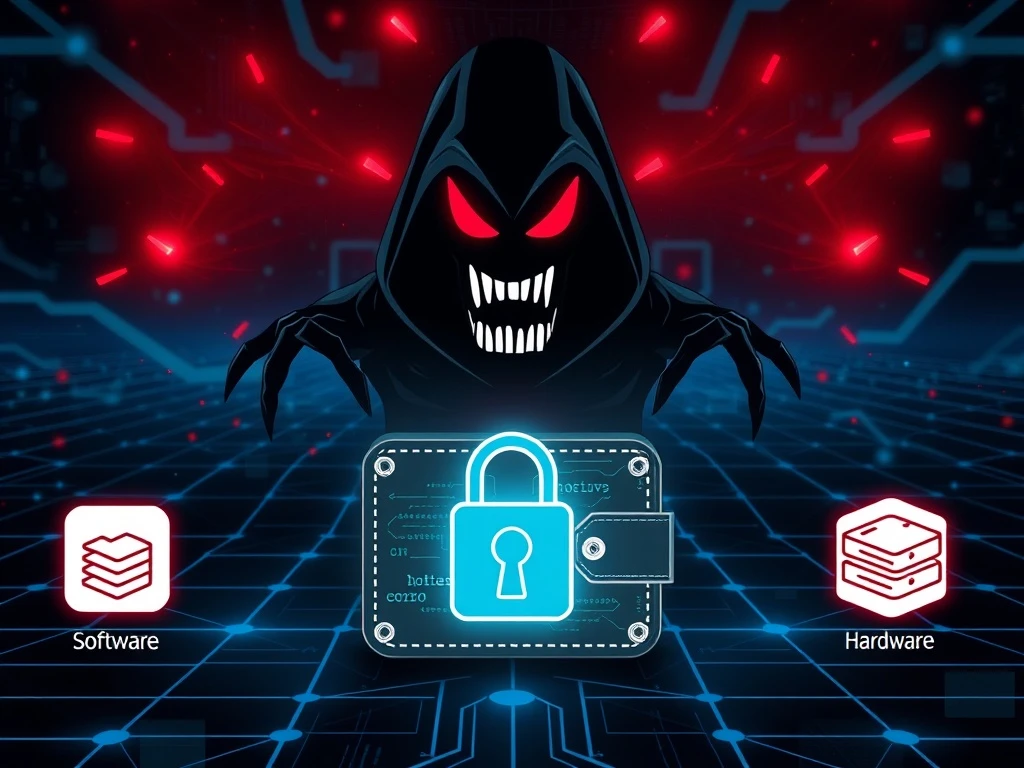Urgent Warning: NPM Exploit Exposes Critical Crypto Security Flaws

A recent Node Package Manager (NPM) incident, though stealing a mere $50 in crypto, sent a powerful ripple through the industry. This seemingly minor event serves as an urgent warning, highlighting persistent vulnerabilities within the broader landscape of crypto security. Experts across the sector now emphasize that this NPM exploit is a clear reminder of the ongoing threats facing digital assets.
The Looming Threat to Crypto Security: An Executive’s Dire Warning
Charles Guillemet, the Chief Technology Officer at Ledger, a prominent hardware wallet company, immediately recognized the gravity of the situation. He declared that while the immediate danger from this specific exploit had passed, the underlying threat remains very real. Guillemet articulated a critical concern: “If your funds sit in a software wallet or on an exchange, you’re one code execution away from losing everything.” This stark statement underscores the inherent risks associated with relying solely on online or hot wallet solutions. Therefore, vigilance is paramount for all crypto holders.
Furthermore, Guillemet highlighted that supply chain attacks continue to be a potent method for delivering malware. These sophisticated attacks target the software development process itself, injecting malicious code before it ever reaches the end-user. Consequently, users can become compromised without even directly interacting with a malicious link. This specific NPM incident perfectly exemplifies such a threat vector, proving that even widely used development tools can become conduits for cybercriminals.
Understanding the Anatomy of the NPM Exploit
The recent NPM exploit unfolded through a cunningly executed phishing scheme. Attackers initially acquired developer credentials by sending deceptive emails from a fake NPM support domain. Once they gained unauthorized access to legitimate developer accounts, they swiftly pushed malicious updates to several widely used software libraries. These compromised libraries included popular names such as ‘chalk,’ ‘debug,’ and ‘strip-ansi,’ among others. The sheer ubiquity of these packages meant that a vast number of applications could potentially become infected.
The injected code had a singular, nefarious purpose: to hijack cryptocurrency transactions. It functioned as a ‘crypto clipper,’ silently intercepting wallet addresses during transactions. The malicious script would then replace the legitimate recipient’s address with an attacker-controlled address within network responses. This sophisticated method allowed the attackers to redirect funds across multiple blockchains, including Bitcoin, Ethereum, Solana, Tron, and Litecoin, all without the user’s knowledge. Such a silent attack mechanism makes detection incredibly challenging for the average user.
Why Software Wallets Remain Vulnerable to Supply Chain Attacks
The incident serves as a stark reminder of the inherent vulnerabilities in software wallets and centralized exchanges. These platforms fundamentally rely on code that runs on internet-connected devices, making them prime targets for various cyber threats. When a supply chain attack, like the recent NPM incident, compromises underlying software libraries, any application or wallet built using those libraries can become infected. This creates a ripple effect, where a single point of failure in the development pipeline can jeopardize countless users’ funds.
Unlike hardware solutions, software wallets often execute code that is not fully isolated from the operating system or other applications. This interconnectedness provides more avenues for attackers to exploit. Furthermore, users often store their private keys directly on these devices, making them susceptible if the device itself is compromised. Therefore, the convenience of software wallets comes with a heightened risk, especially when sophisticated supply chain attacks are involved.
Hardware Wallets: A Fortified Defense for Crypto Security
In the face of escalating threats like the NPM exploit, hardware wallets emerge as a superior solution for robust crypto security. Charles Guillemet strongly advocated for their use, emphasizing their unique features designed to withstand such attacks. One crucial feature is ‘clear signing,’ which ensures that users physically verify the exact details of a transaction on the hardware device’s trusted screen before signing it. This process prevents malicious software from silently altering transaction details, such as recipient addresses.
Another vital safeguard is the transaction check mechanism. Hardware wallets isolate private keys in a secure, offline environment, completely separate from your internet-connected computer or smartphone. This isolation means that even if your computer is riddled with malware, your private keys remain safe. Attackers cannot access them to sign malicious transactions. Consequently, features like these provide an unparalleled layer of protection against sophisticated attacks, making hardware wallets an indispensable tool for serious crypto holders.
Developer’s Call to Action: Securing the Software Supply Chain
Anatoly Makosov, the Chief Technology Officer of The Open Network (TON), provided critical insights into the technical specifics of the NPM exploit. He confirmed that only specific versions of 18 packages were compromised, and thankfully, rollbacks to safe versions were quickly published. Makosov detailed how these compromised packages acted as “crypto clippers,” silently spoofing wallet addresses within products relying on the infected versions. This meant web applications interacting with various blockchains risked having transactions intercepted and redirected without user knowledge.
Makosov stressed that developers who pushed their builds within hours of the malicious updates were most exposed. Additionally, applications configured to auto-update their code libraries, rather than freezing them to stable, safe versions, faced significant risk. This highlights a crucial vulnerability in modern development practices, where reliance on automated updates can inadvertently introduce malicious code. Therefore, careful management of dependencies is essential for maintaining strong crypto security.
Proactive Measures for Developers Against Future NPM Exploits
To combat the ongoing threat of supply chain attacks and prevent future NPM exploit incidents, Anatoly Makosov shared a practical checklist for developers. This guide helps them determine if their applications were compromised and outlines the necessary steps for remediation. Key indicators of compromise include:
- Using Compromised Versions: Checking if the code utilizes any of the 18 specific versions of popular libraries, such as ‘ansi-styles,’ ‘chalk,’ or ‘debug.’ If a project relies on these versions, it is highly likely compromised.
- Unusual Network Activity: Monitoring for any suspicious outgoing connections or unexpected data transfers from the application.
- Code Integrity Checks: Regularly verifying the integrity of installed packages against known good hashes.
The fix, Makosov advised, involves several critical steps: switching back to safe, uncompromised versions of the libraries, completely reinstalling clean code, and thoroughly rebuilding applications. He confirmed that new and updated releases are already available, urging developers to act quickly. Swift action is crucial to clear out the malware before it can affect users and cause significant financial losses. Implementing these best practices significantly enhances overall crypto security.
Broader Implications for the Crypto Ecosystem and User Trust
This incident, despite its small financial impact, carries significant implications for the entire crypto ecosystem. It underscores the continuous battle against sophisticated cyber threats and the fragility of trust in a decentralized environment. Every successful supply chain attack or NPM exploit, regardless of scale, erodes user confidence in the security of digital assets. This erosion of trust can hinder mainstream adoption and stifle innovation within the space. Therefore, the industry must prioritize robust security measures at every level.
Furthermore, the incident highlights the interconnectedness of the crypto world. A vulnerability in a seemingly unrelated software library can directly impact the security of users’ funds. This necessitates a collaborative approach to crypto security, where developers, wallet providers, and exchanges work together to identify and mitigate risks. Continuous education for users on best practices, such as the benefits of hardware wallets, is also paramount to fortify the ecosystem against future attacks.
Staying Ahead of the Curve: Essential Crypto Security Practices
The failed NPM exploit serves as a potent reminder that the digital asset landscape is a constant battleground for crypto security. While immediate dangers may subside, the underlying threats, particularly from sophisticated supply chain attacks, persist. Users must adopt a proactive approach to protect their investments. This includes understanding the differences between software wallets and hardware wallets and making informed choices about where and how to store their digital assets.
For developers, the message is equally clear: vigilance in managing dependencies and implementing stringent security protocols throughout the development lifecycle is non-negotiable. Regularly auditing code, freezing library versions, and responding swiftly to security alerts are crucial. Ultimately, safeguarding the future of cryptocurrency depends on a collective commitment to robust security practices. Stay safe, stay informed, and always prioritize the security of your digital assets.









